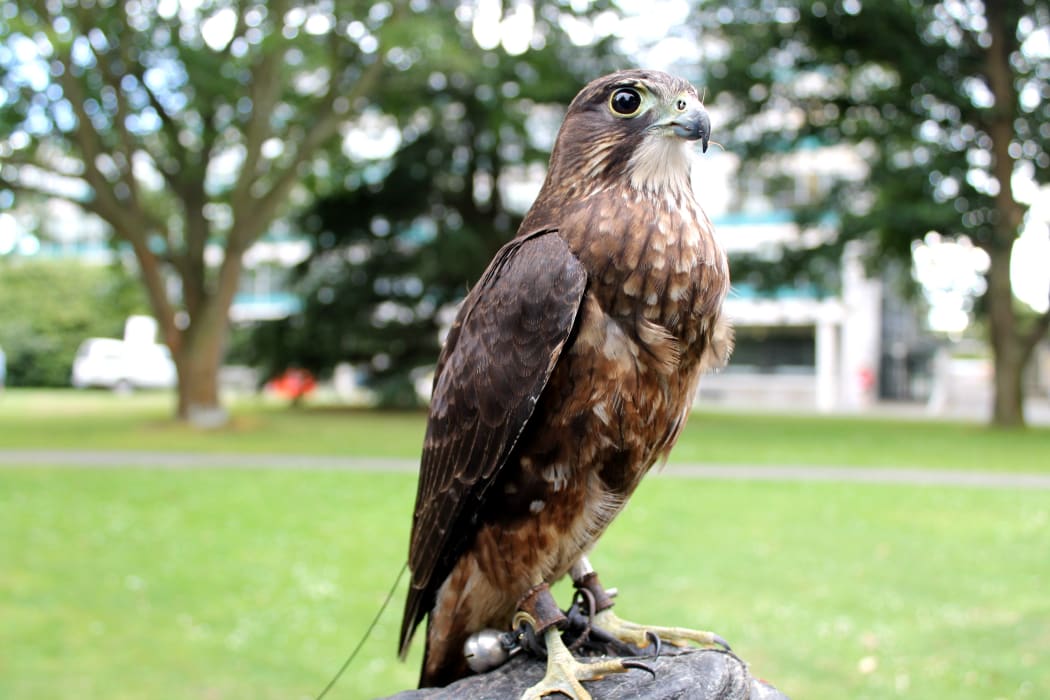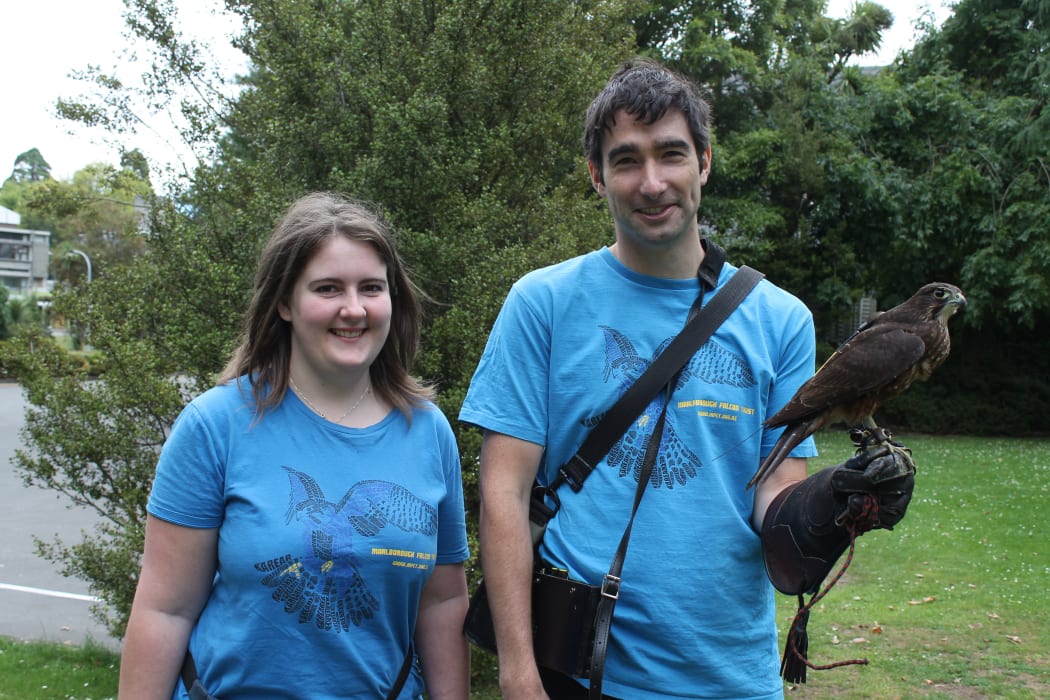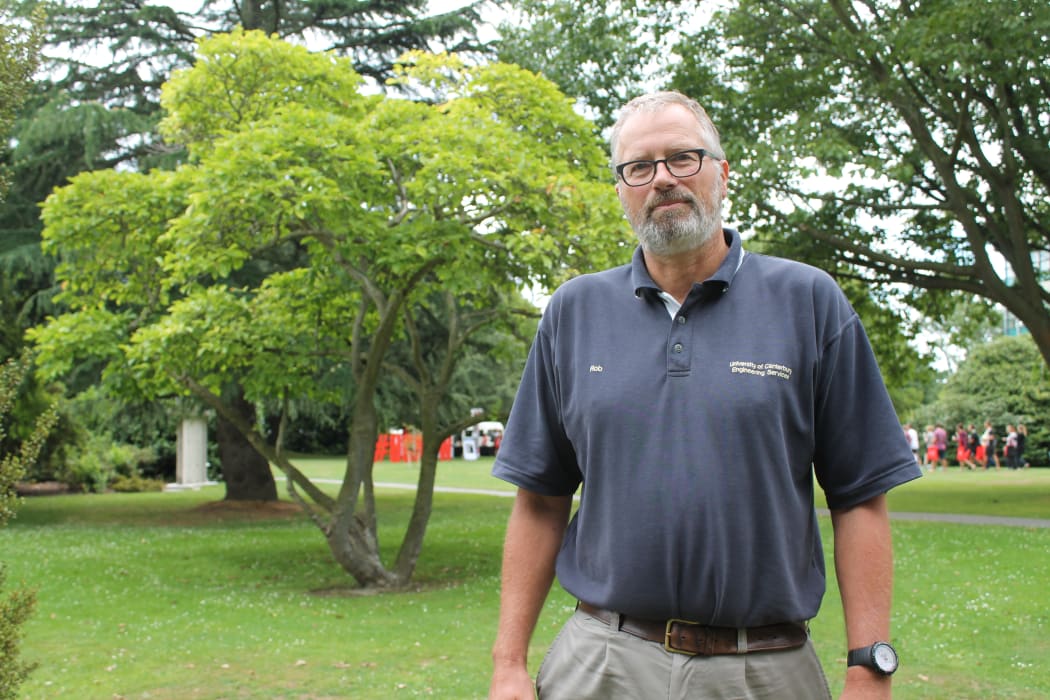Q: What's a university to do when pigeons invade its campus?
A: Employ a predator to patrol the grounds, specifically an endangered New Zealand falcon.

Tappe, a New Zealand falcon Photo: Katy Gosset/RNZ
Katy Gosset meets Tappe and his handlers and talks to students about their chance to see a rare species up close.
Building a Bond
It's 4.00 in the morning. Rob Lawry finds himself roving the streets of Fendalton, a leafy Christchurch suburb. He's spent 13 hours on the hunt for his elusive charge, an endangered New Zealand falcon named Tappe. But just as he is picking up a weak radio signal in a suburban street, Tappe finds him first and flies down to the glove.
"When he sees you and he's that happy to come to the glove you know that things are alright."
He says it's part of the bond between the falcon and falconer. "That actually was really good in a way because it showed him that I care enough to come looking for him."
The pair have been working towards a specific goal: ridding Canterbury University of its persistent pigeon population.
Lawry says Tappe was trained to scare the pigeons off rather than kill them and he would patrol the campus several times a week.
"The idea is to reduce the need for more lethal forms of control while also promoting the knowledge and use of native species."

Falconers, Vikki Smith and Rob Lawry, with Tappe. Photo: Katy Gosset/RNZ
Mr Lawry has himself been taught by Vikki Smith, an experienced falconer from the United Kingdom. However, Ms Smith said falconry in the UK was mainly focused upon hunting and predatory birds were trained in a very regimented way.
"It's a hawk so it's completely different from other birds so it has to be trained in a traditional style."
But she found that the different approach in New Zealand can also work well. "I've had really good results with [Tappe], training it almost as though you would train a parrot."
But some things remain the same here. The leather glove is still necessary, as are falconry bells in two different tones. These are attached to his feet and make it easier to find Tappe when he's in a tree.
Ms Smith says most falconers use the left arm to hold the falcon, while the right arm does everything else.
"To start with you get a little bit of a stiff arm but after a while you get used to it...Also your right arm ends up getting really tanned and your left arm doesn't."
Training Tappe
Tappe came from the Marlborough Falcon trust where he was raised to view humans as siblings. Rob Lawry said that had to be done at the right age otherwise the falcon could view humans as his parents and become aggressive, believing them to be withholding food.

"Titbitting" the falcon helps develop a bond between the bird and its falconer. Photo: Katy Gosset/RNZ
That's followed by a process called "manning" in which the bird gets used to being around people. The falconer offers titbits in exchange for the bird taking on an increasingly challenging range of tasks such as jumping to the glove and then flying in a line known as a "creance".
"This builds up trust over time: the falcon knows you're not going to do anything horrible to him and he's seen you as a reliable food source."
He says after a falcon has flown on the creance, it's important to let it fly free. "That's a really good indicator because if they fly free and they go away, either you've done it wrong or they weren't happy with something."
Mr Lawry says if a falcon returned, even after a couple of days, it showed the bond was still strong. He says the freedom of the relationship is one of the appeals of the sport.
"The bird can always fly off. If he decides life with you is bad, he's gone and that's great because that means you've got to be friends."
Teaching Students
There are only about 6000 New Zealand falcons left in the wild and Mr Lawry says one benefit of the bio-control programme is providing an opportunity to see an endangered species.
"He's here just to show a lot of the students what a New Zealand falcon looks like because a lot of people haven't seen one."

Rob Lawry shows the falcon to a student, Aaron Reed. Photo: Katy Gosset/RNZ
And certainly on Tappe's first day among the full university population, there were plenty of questions about the bird's diet, call, and hunting techniques.
Mr Lawry says it was the kind of response he'd been hoping for. "You want people to be excited by our native birds because they're all really unique and really amazing so all of them need to be looked after."
Problematic Pigeons
So why is the falcon necessary? The Manager of Engineering Services, Rob Oudshoorn, says the university's tall buildings with its nooks and ledges have always proved popular to pigeons to roost in.
It was a "low level" problem until the Canterbury earthquakes but then the lack of other tall buildings to roost in caused more pigeons to visit the campus.
"There was a significantly large food source available from the city, from the quake and debris that allowed that population to explode."

The university's Manager of Engineering Services, Rob Oudshoorn. Photo: Katy Gosset/RNZ
Mr Oudshoorn says the university had invested time and money to both cull pigeons and to redirect them away from certain areas with scent trails and electric fences.
These measures required specialist placement by abseilers who were also needed to clean up debris from ledges.
But he hopes this latest solution, involving Tappe, would prove a sustainable one.
"No chemicals, nothing like that, it's just training of a bird and some labour to make it happen."
He says he will collect data on the bio-control programme but there was already evidence that Tappe's presence was having an effect on the pigeon population.
"It's fantastic to see the profile that the bird has gained from this and we hope to see it being effective in what we need to do here."

